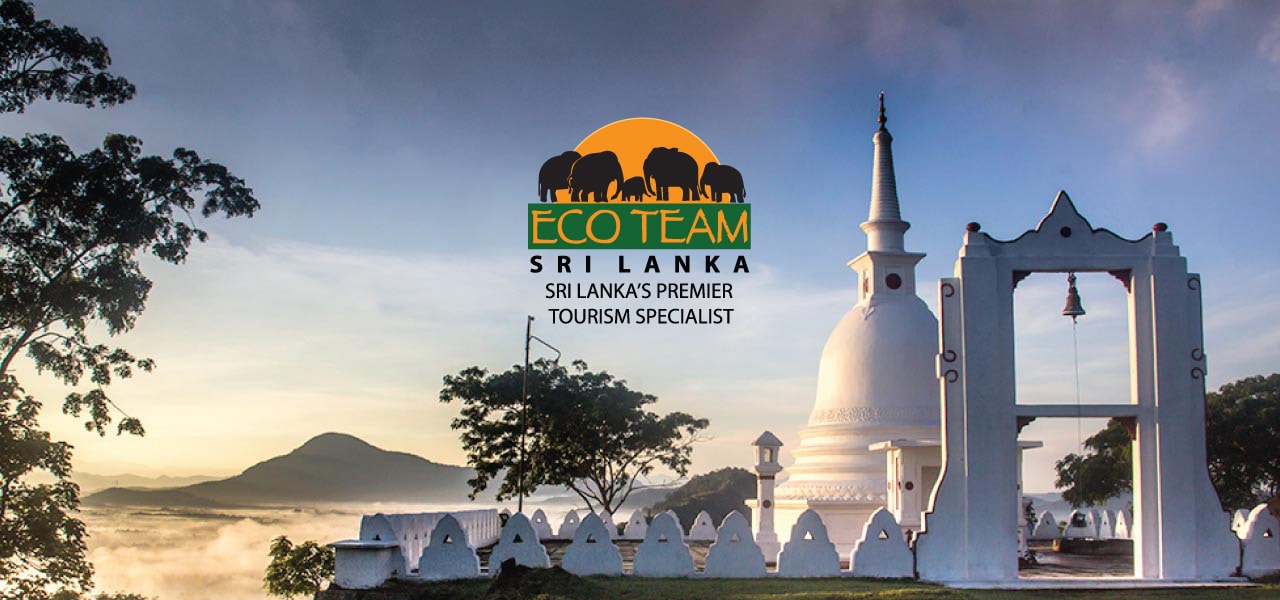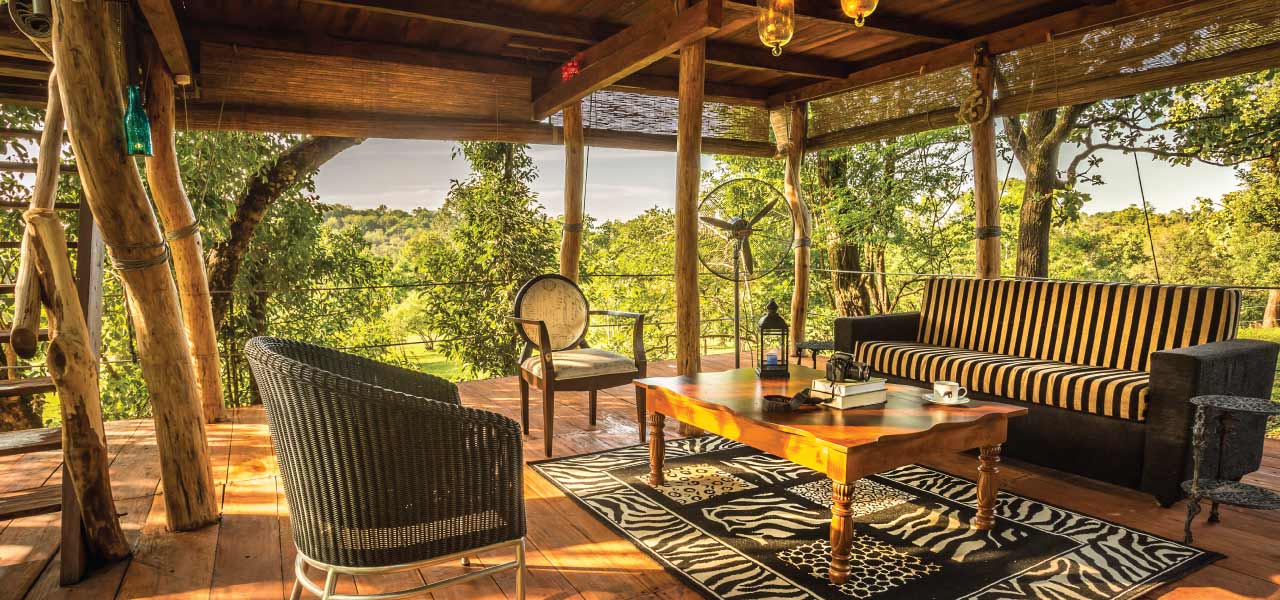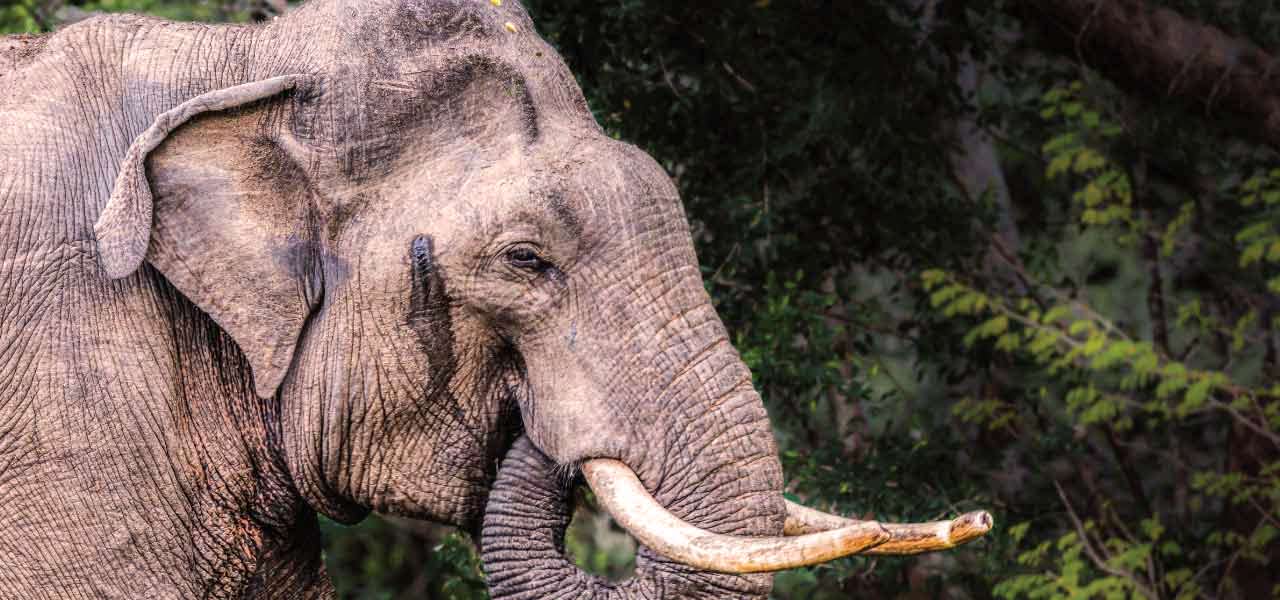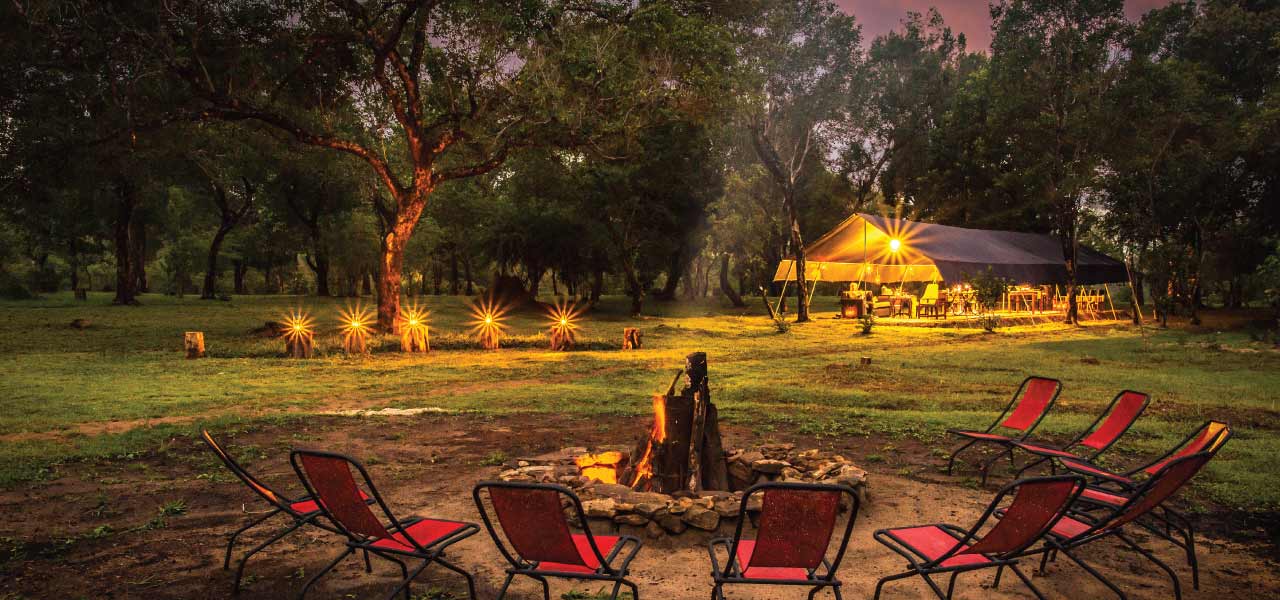
Lunugamvehera
Covering an area of 24,000 hectares, Lunugamvehera National Park was established for protection of elephants migrating from Yala to Udawalawe National Park. The dry-mixed forests are rich in biodiversity and a home to a large number of wild elephants and buffaloes. Also, some other species of mammals such as fishing cat, grey mongoose, wild boar, spotted deer and mouse deer are found in this area.
Lunugamvehera National park extending to 23,499 hectares mixed with dry evergreen forests of flora and 3,283h occupied with the Lunugamvehera reservoir. The national park is an important habitat for water birds and elephants as a corridor for elephants to migrate between Yala National Park and Udawalawe National Park.
It is estimated that Fauna of the park includes 21 fish species, 12 amphibians, 33 reptiles, 183 birds and 43 mammals.
The Park, being a dry zone forest records temperature close to 30 degrees centigrade with rain between November and January each year making the park suitable for visiting all year round.
Climate and vegetation in Lunugamvehera National Park
The park is located 261 km southwest from Colombo, Monargala in Uva Province. Lunugamvehera is in the Dry zone of Sri Lanka; therefore the park is exposed to annual drought, relieved by the south western monsoon.
There are two access points to the park. The entrance to the park is located on the Hambantota-Wellawaya road near Thanamalwila and the other entrance is from the Galge on Sella Kataragama – Buttala Road. This entrance is more suitable to access the Veheragala Reservoir or the Ruins. There is very little traffic from this entrance since most prefer Yala over this National Park but this area too is filled with wildlife.
Safari at Lunugamvehera
There are 3 safari options available for the guest.
1. Morning Safari (6.00am)
2. Afternoon Safari (2.30pm)
3. Full day Safari
The safari would take place with an experienced guide in specially modified comfortable jeeps for unique safari experience. The tour could be more customized for guests for their preferences (Family safari, honeymoon safari, photography safari etc.).
Tour in brief
Initial meeting with the Ecoteam crew and the safari guide, a brief of the tour will take place in the entrance to the Lunugamvehera Safari. For the morning half-day tour, the starting time will be at 6 a.m. while the afternoon tour begins at 2.30 p.m.
After entering the national park with your guide in a jeep, you will be able to spot several species of birds and other animals that have made their homes in this sanctuary. The guide will explain about the various interesting attributes as you will learn and enjoy about the flora and fauna of Lunugamvehera
You will be taken through most of the Lunugamvehera National Park, covering the wetlands, grasslands, forest patches, etc. We will make longer stops at certain watering holes for unique photography opportunities.
Finishing the safari, either round 11 a.m. or around 6 p.m. you will be dropped at the park entrance.

Kalawewa
Lined with massive kumbuk trees, Kalawewa National Park is a beautiful expanse of forest surrounding the giant Kalawewa and Balalu Wewa tanks, constructed by King Datusena in the 5th Century. Expanding over 6000 hectares, this park has the largest concentration of tuskers in Sri Lanka.
Kalawewa was designated as national park in 2015, and it is the perfect destinations for the wildlife enthusiasts who love the untouched wilderness. During the dry season, when the water levels recedes and the tank bed becomes a lush grassland providing the animals with fodder, the big herds of up to 50 elephants gather around the banks of the reservoirs. The park has a fascinating birdlife too. During the driest months of the year, large flocks of thousands of open-billed storks can be seen at once.
Elephants in Kalawewa
According to the elephant census carried out in 2011 by the Wildlife Conservation Department, Sri Lanka is home to 5,879 elephants out of which only about 120 are tuskers.
Elephants are highly intelligent animals that form deep family bonds and display complex social behaviors as well as a number of adaptations that help them maintain communication. They have a very sensitive hearing and memories that span many years.
Elephants live in tight matriarchal family groups of related and non-related females, juveniles and calves. A typical herd has 4 to 8 elephants, and it comprises of both related and non-related adult females, juveniles and calves. It is led by the oldest female, called a matriarch, that guides the herd from area to another to find fodder and water according to the same foraging patterns year after year.
All male, or bull elephants do not have tusks - in Sri Lanka only about seven per cent of male elephants have them. In general, bulls live a solitary life, alone or in loose association with other bulls. In early years of adulthood, males are driven out of the family group and they start learning the capabilities of other bulls in their area. Bulls have a very clear pecking order and a social hierarchy determinates their status when they start seeking for females.
Regularly, elephants come together to feed, socialise and raise their babies. Depending on the region, these mega herds can have from 50 up to thousands of elephants. During the dry season in Kalawewa, elephants herds from the sanctuary as well as the herds from nearby jungle areas gather to the banks of the reservoir. Then, when the monsoon rains commence in October-November, the reservoir fills up and the grasslands submerge. While the resident herds remain in the area, the migratory herds return to their homelands.

Horton Plains
The famous Horton Plains is a nature reserve characterized by a beautiful landscape of rolling hills, forests, and grassland. The highest plateau in the island, spanning approximately 10,000 hectares, is home to 24 species of mammal - such as elk, deer, giant squirrel, wild boar, wild hare, porcupine, and leopard. The park also hosts unique vegetation and offers a perfect ground to observe many rare and endemic highland birds (87 species, 14 of which are endemic). An impressive physical feature in Horton Plains is the escarpment that falls 880 meters to the lowlands of the southern region of the island. Aptly known as the "World’s End", the precipice boasts a fabulous view of the tea estates below and all the way out to the distant southern coastline.
Horton Plains, or 'Mahaeliya' as it is traditionally named, is a popular weekend destination amongst locals. Therefore, we recommend to visit the park on a weekday when it is more peaceful.
Climate and Vegetation in Horton Plains National Park
The Horton Plains are located on Sri Lanka's highest plateau, between altitudes of 2,000 and 2, 300m. The landscape consists of undulating lands covered with tropical cloud of forests or verdant montane savannah grasslands, locally known as patannahs.
The best time to visit is early in the morning when the sky is the clearest and you can enjoy the best of the views. In the afternoons, clouds tend to descend and the area becomes submerged in mist. This is equally enthralling though and provides evidence for the evolution of this forest type. Allowing a half-day should give you plenty of time to enjoy it all at a leisurely pace.
History and Wildlife
Horton Plains were named after Sir Robert Wilmot Horton, a rather selfish and bloody-minded Brit who was singularly responsible for the slaying of all of the elephants in the area between 1831 to 1837. Although there is little hope of elephants ever returning, you may walk around admiring the many other interesting creatures around and about.
These highlands are home to one of Sri Lanka's least known mammals, the mouse-deer. For many years, it was believed that the mouse-deer found in Sri Lanka was the same species as in Southern India. In June 2005, Colin Groves a British taxonomist published a paper in a special supplement (No 12) of The Raffles Bulletin of Zoology whereby he distinguished three species of mouse-deer from Sri Lanka and India. The Indian mouse-deer (Moschiola indica) was split as a new species, and is considered now endemic to the Eastern Ghats of India. Also, the mouse-deer found in Sri Lanka was split into two new species: the white-spotted mouse-deer found (Moshiola meeminna) in the dry zone of Sri Lanka and the yellow-striped mouse-deer (Moschiola kathygre) found in the wet zone. Both species are endemic to Sri Lanka. Presently, this raised the number of endemic mammals found in Sri Lanka to eighteen species.
In his paper on mouse-deer from India and Sri Lanka, Colin Groves stated also that “a single skull from Sri Lanka's Hill Zone may prove to represent a fourth species”. The 'mountain mouse-deer' is evidently a very scarce animal. Most of the field staff in Horton Plains National Park had not seen one although they regularly encounter other nocturnal mammals including leopard.
In February 2008, a mountain mouse-deer was seen in quite exceptional circumstances by the wildlife populariser Gehan de Silva Wijerathne and Nadeera Weerasinghe, naturalist at St. Andrew's Hotel. With the permission from WLDC, it was temporally held captive for research and observation purposes and released back to the wild 2 days later.

Sinharaja
Sinharaja rainforest has been designated as a UNESCO Natural World Heritage Site, UNESCO Biosphere Reserve and also a Biodiversity Hotspot by the International Union for Conservation of Nature (IUCN). All these titles are highlighting the importance of the forest reserve in terms of its exceptional biodiversity as well as its fragility. Birding in Sinharaja is particularly interesting since it is home to 95% of the endemic birds of Sri Lanka!
Named as a world heritage site in 1989, this lowland evergreen rain forest is steeped in deep legend and mystery. In English 'Sinharaja' translates to Lion (Sinha) King (Raja) alluding to a popular belief according to which the origin of the Sinhala people is from the union between a princess and the lion king who once lived in this forest.
Climate and Topography in Sinharaja
Sinharaja rainforest consists of a series of continuous ridges, aligned approximately in an east-west direction and lies between the tributaries of the Kalu Ganga in the north and the Gin Ganga in the south. The forest lies within the transition zone of two important groups of rock types, the south/western group which consist of metasediments-charnockites and scapolite bearing calc granulites and the highland group comprising khondalites of metamorphosed sediments and charnockites.
The elevation of the Sinharaja reserve ranges from 200m to 1300m. It has a rolling terrain consisting of a series of ridges and valleys, which assumes an east-west trend in the northwestern part of the reserve. In other parts of the reserve, the ridges and valleys assume a north-west/south-east alignment. The peak of Hinipitigala is the tallest, rising up to about 1150m.Other important ridges in the reserve ranges between 550-800m in height NamelyMoulawella (760m), Kosgulana (797m), Sinharaja (742m), Kohilearambe (575m), Dotalugala (769m), and Tibbottagala (904m).
The most significant geological feature of Sinharaja is the presence of a "Sinharaja Basic Zone" which comprises hornblende pyroclasts, basic charnockites pyroxene amphibolites and scapolite.The soils of Sinharaja largely belong to the group of Red Yellow Podzolic soils, with clearly distinguishable horizons of varying soil depths. The soil is well drained with very little accumulation of organic matter.
Vegetation
The vegetation of Sinharaja may be described either as a Tropical Lowland Rain Forest or Tropical Wet Evergreen Forest. Some striking characteristics of the forest are the loftiness of the dominant trees, the straightness of their bole, the abundance of regeneration and the diversity of species.
The average height of the trees varies between 35-40m. Some individuals rise up to 50m.
Contrary to popular belief scrub growth does occur on rock shelves or gaps on the canopy created by falling of over-mature trees. The great diversity of species of Sinharaja forest makes it difficult to distinguish ecological patterns. However, some tree associations have been recognized and these are the Dipterocarpus (Hora-Bu Hora) an association confined to the lower elevations along the Gin Ganga valley and the Mesua-Doona (Shorea) association forms the matrix of the Sinharaja forest.
The vegetation of Sinharaja is that of humid wet evergreen forest type with a high degree of endemism. In fact some families such as Dipterocarpaceae show an endemism more than 90%. The untapped genetic potential of Sinharaja flora is enormous. Out of the 211 woody trees and lianas so far identified within the reserve 139(66%) are endemic. Similarly, high levels of endemism are perhaps true for the lower plants like ferns, Epiphyts as well. Out of 25 general endemic to Sri Lanka 13 are represented in Sinharaja.
The total vegetation density, including trees, shrubs, herbs and seedlings has been estimated to be around 240,000 individuals per hectare, of which 95% comprise individuals of the ground layer below 1m in height. The density of trees, lianas above 30 cm girth at breast height, ranges between 600-700 individuals/ha. While the number of merchantable individuals of trees of girth greater than 150 cm. Ranges between 45-55 individuals/ha.
Wildlife in Sinharaja
Preliminary studies on the fauna of Sinharaja have revealed that there is a high degree of endemism among the butterflies, fish, amphibians, reptiles, birds and mammals. In fact 95%of the endemic birds of Sri Lanka are recorded in Sinharaja. Endemism among mammals and butterflies are also greater than 50%.
Out of the larger mammals, although elephants were said to be common in the past, there have not been reports of sightings during the last 15 years. However, there have been reports of sightings of a few animals in the Eastern Sector. The most common deer species is the sambhur. The mouse-deer and barking deer are also found within the reserve. Leopards are very seldom sighted, but their frequent presence has been confirmed by tracks and other signs. Brown Mongoose and the golden-palm civet have been occasionally sighted. The most commonly seen primate is the purple-faced leaf monkey.
Out of the birds recorded in the Western sector of the reserve, 72% were resident non- endemic and 13% migrants. One of the most interesting and colorful spectacles to be found in the Sinharaja is the presence of mixed species of foraging bird flocks, a phenomenon commonly found in rainforests. A total of 100 such flocks were systematically observed, and studies have revealed that some flocks contained 48 species including 12 endemic species. The rare endemic birds to be seen in Sinharaja are the red-faced malkoha, the Sri Lanka blue magpie, the ashy-headed babbler, the white-headed starling and the green-billed coucal the rarest of Sri Lankan birds.
The agamids are the best-represented group of reptiles, the most common being the Green Garden Lizard of special significance are the sightings of Calotes liolepis an arboreal species, the rarest of all agamids found in the island. The only tortoise recorded in the reserve is the hard-shelled terrapin, while of the species of skinks, the spotted skink can be seen often. Among the snakes the green pit viper and hump- nosed viper are commonly found in this forest and are endemic to Sri Lanka.
The amphibians are fairly well represented in the reserve and nine endemic species have been identified. The endemic Torrent toad and the common house toad. In most streams and marshes, the Wrinkled frog and the Sri Lanka Reed frog also found in Sinharaja. Ramanella palmata a rare endemic species is the only microhylid recorded so far while the yellow- banded Caecilian is the only apodan recorded.
It’s people
Sinharaja is surrounded by 22 villages with a population of approximately 5000 people. Only two villages, Warukandeniya and Kolonthotuwa are located within the reserve. The long history of human habitation in and around today's reserve, in fact compounds the problem of managing and conserving the forest. Most of the ancient harmless are found along the southern boundary of the reserve on the bank of Gin Ganga with a few located on the north- western side. Numerous ancient footpaths exist on the periphery of the reserve while there are three footpaths that run across the interior of the forest.
The family structure is that of an extended family with parents, children and grandparents living together. The houses have small floor area, averaging 25 sq. meters and are constructed of wattle and daub. The roof is thatched with leaves of a forest treelet called Beru or with Bamboo leaves. Lately however, coconut leaves for thatching and clay tiles have begun to gain popularity as roofing materials.
The staple food of the villagers is rice, Yams such as sweet potato and Manioc (Cassawa), Breadfruit and Jackfruit, grown in home gardens are often used as substitutes for rice. Other plants commonly found in home gardens are vines of betel (Piper betel) black pepper and passion fruit. Fruit trees such as papaya and banana are also grown. For most of their other needs the villagers depend on plants often found in the forest. The sap needed for the manufacture of Jaggery is obtained tapping the in Florence of the Kitul palm (Caryota urens).
Another source of income is the manufacture of baskets and mats from rattan on 'wewal'. The villagers also exploit other plant products such as wild cardamom, resinous exudates used as fumigating agents from Nawada ( Shorea stipularis ) and other shorea species.
The exudates from Kekuna ( Canarium zelani-cum ) is used as a caulk for damaged boats and as glue for domestic purposes. Numerous plants used in the native 'ayurvedic' system of medicine are also collected and sold by the villagers, of particular significance being the stem of Weniwel (Coscinium fenestratum) used by most Sri Lankan as an antidote for tetanus. Beraliya ( Shorea megistophylla ) provides a fruit which is often used as a substitute for flour.

Kumana
Located in the southeast corner of Sri Lanka, Kumana National Park is renowned as bird sanctuary where large flocks of migratory waterfowl and wading birds can be seen. From May to June, many water birds nest in the mangrove swamps surrounding the 200-hectare Lake Kumana Villu. The species inhabiting this area include pelicans, painted storks, spoonbills, white ibis, herons, egrets and little cormorants. Also, the very rare black-necked stork has been spotted here. Besides the abundant birdlife, Kumana is home to many mammals such as elephants and leopards.
The Kumana Bird Sanctuary, located within the boundaries of Kumana National Park, was declared a protected area in 1938, and it is rated as one of the most important breeding grounds for birds in Sri Lanka.
Climate and vegetation in Kumana
In Kumana, there are about 20 shallow lagoons and lakes that have a major contribution to the abundant birdlife. The wetland zones are surrounded by dry zone tropical thorn forest, whereas inland forests consists mainly of Manilkara hexandra, known as Palu in Sinhalese. Also a wide range of aquatic plants, trees and reeds is found in Kumana.
Birdlife in Kumana National Park
A total of 255 species of birds, including the very rare black-necked stork, have been recorded in Kumana. On a birding safari pelicans, painted storks, spoonbills, white ibis and cormorants are commonly seen, as well as pacific golden plover, greater sand plover, lesser sand plover, grey plover, ruddy turnstone, little ringed plover, wood sandpiper, marsh sandpiper, common redshank, common sandpiper, curlew sandpiper, little stint, common snipe, and pintail snipe.
The Asian openbill, glossy ibis, purple heron, great egret, Indian pond heron, black-crowned night heron, intermediate egret, little egret, spot-billed pelican, Indian cormorant, little cormorant, common moorhen, watercock, purple swamphen, white-breasted waterhen, pheasant-tailed jacana, black-winged stilt, lesser whistling duck and little grebe migrate here in large flocks. The migrant birds fly up to 9,000 kilometres from Siberia to arrive in these Southern regions of Sri Lanka. Rare migrants include yellow-footed green pigeon, greater racket-tailed drongo, malabar trogon, red-faced malkoha, and sirkeer malkoha.
Safari at Kumana
There are 3 safari options available for the guest.
1. Morning Safari (6.00am)
2. Afternoon Safari (2.30pm)
3. Full day Safari
The safari would take place with an experienced guide in specially modified comfortable jeeps for unique safari experience. The tour could be more customized for guests for their preferences (Family safari, honeymoon safari, photography safari etc.).
Tour in brief
Initial meeting with the Ecoteam crew and the safari guide, a brief of the tour will take place in the entrance to the Kumana Safari. For the morning half-day tour, the starting time will be at 6 a.m. while the afternoon tour begins at 2.30 p.m.
After entering the national park with your guide in a jeep, you will be able to spot several species of birds and other animals that have made their homes in this sanctuary. The guide will explain about the various interesting attributes as you will learn and enjoy about the flora and fauna of Kumana.
You will be taken through most of the Kumana National Park, covering the wetlands, grasslands, forest patches, etc. We will make longer stops at certain watering holes for unique photography opportunities.
Finishing the safari, either round 11 a.m. or around 6 p.m. you will be dropped at the park entrance.








































